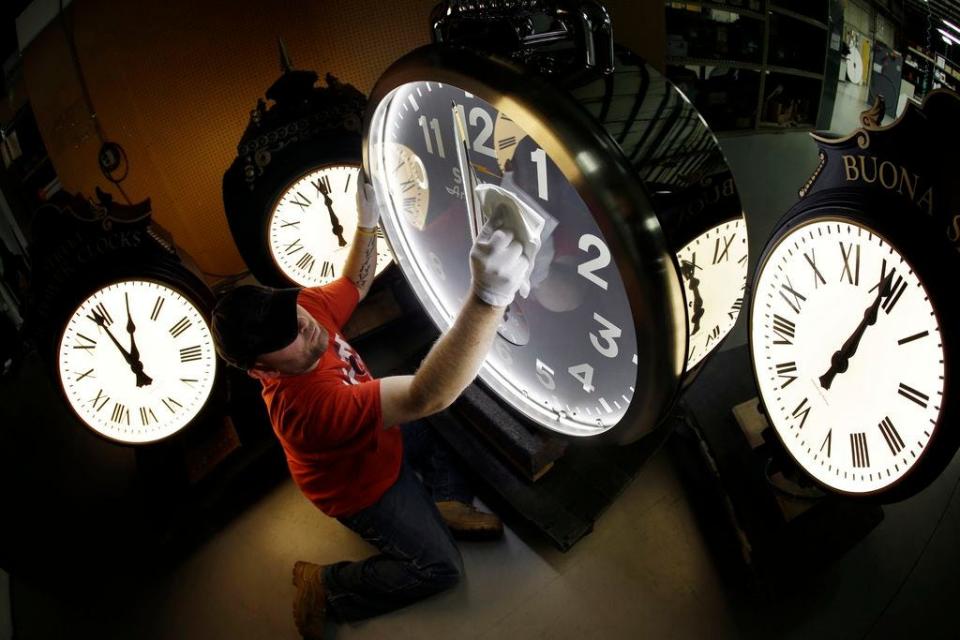When does daylight saving time start in NC? Here's when to 'spring forward' in 2024
ASHEVILLE - In March, Western North Carolina will see its clocks "spring forward," and people will lose an hour of sleep as daylight saving time begins for the year.
The time shift, also referred to as “spring forward, fall back,” will happen at 2 a.m. Sunday, March 10. For most people, this means setting clocks ahead before going to bed Saturday night. For the majority of states, including North Carolina, autumn ushers in a return to standard time, when clocks are set back one hour.
The time adjustment affects the daily lives of hundreds of millions of Americans, prompting clock changes, contributing to less sleep in the days following and, of course, later sunsets, says USA TODAY reporting.

What is daylight saving time?
Daylight saving time occurs between March and November when most Americans adjust their clocks by one hour.
Western North Carolinians lose an hour in March (as opposed to gaining an hour in the fall) to accommodate for more daylight in the summer evenings. When we "fall back" in November, it's to add more daylight in the mornings.
In the Northern Hemisphere, the vernal, or spring equinox is March 19, marking the start of the spring season.
When is daylight saving time 2024?
Daylight saving time will begin for 2024 at 2 a.m. local time on Sunday, March 10, when our clocks will spring ahead one hour.
When does daylight saving time end in 2024?
In 2024, daylight saving time will end for the year at 2 a.m. local time on Sunday, Nov. 3. It will pick up again next year on Sunday, March 9, 2025.
Will NC make daylight saving time year-round?
Efforts to stop the twice-yearly clock switching, which some call "disruptive," are nothing new.
State legislatures have considered at least 450 bills and resolutions in recent years to establish year-round daylight saving time as soon as federal law allows it, according to the National Conference of State Legislatures.
Inherent in the debate is whether to enact either permanent standard time or permanent daylight time. The federal Uniform Time Act allows the former option but not the latter.
The U.S. Senate unanimously approved a bill called the Sunshine Protection Act in 2022. Introduced by Sen. Marco Rubio, R-Florida, the act would permanently extend daylight saving time for the entire year. However, it did not pass in the U.S. House of Representatives and was not signed into law by President Joe Biden, according to USA TODAY reporting.
A 2023 version of the act remained idle in Congress as well.
In the last five years, 19 states have enacted legislation or passed resolutions to provide for year-round daylight saving time, if Congress were to allow such a change, and in some cases, if surrounding states enact the same legislation, according to NCSL. Because federal law does not currently allow full-time DST, Congress would have to act before states could adopt changes.
N.C. House Bill 326, which would adopt DST year round, was introduced in March in the General Assembly. It passed the House in May, but stalled in the Senate.
Chris Cooper, a political science professor at Western Carolina University, said in February that if efforts were to resume when session begins in April, a bill would have to be reintroduced.
When did federal time changes start?
The Standard Time Act of 1918 was the first law to implement standard and daylight saving times at the federal level.
"Federal oversight of time zones began in 1918 with the enactment of the Standard Time Act, which vested the Interstate Commerce Commission with the responsibility for establishing boundaries between the standard time zones in the U.S.," according to the U.S. Department of Transportation. "This responsibility was transferred from the Interstate Commerce Commission to DOT when Congress created DOT in 1966."
Why?
The U.S. Department of Transportation oversees the observance of daylight saving time as well as U.S. time zones, according to transportation.gov. The DOT said energy reduction and reduced crime are reasons for having both standard and daylight saving time.
Which states don't observe daylight saving time?
Arizona (except for the Navajo Nation) and Hawaii do not recognize daylight saving time. Neither do Puerto Rico, the U.S. Virgin Islands, American Samoa, Guam and the Northern Marianas.
Sarah Honosky is the city government reporter for the Asheville Citizen Times, part of the USA TODAY Network. News Tips? Email shonosky@citizentimes.com or message on Twitter at @slhonosky. Please support local, daily journalism with a subscription to the Citizen Times.
This article originally appeared on Asheville Citizen Times: When does daylight saving time start for WNC in 2024? What is it?

